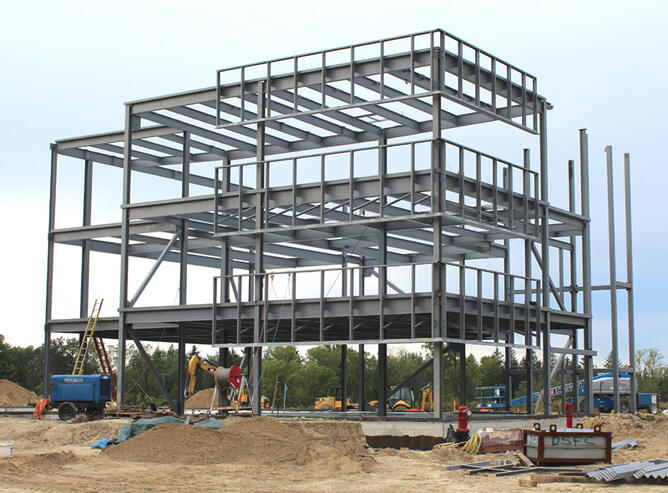The Evolution of Sustainable Retail Architecture
Modern retail architecture has undergone a remarkable transformation, with steel structure shopping malls emerging as pioneers in sustainable commercial development. These innovative structures represent a perfect fusion of architectural brilliance and environmental consciousness, setting new standards for eco-friendly retail spaces. The integration of steel as the primary construction material has revolutionized how we approach retail development, offering solutions that are both environmentally responsible and economically viable.
As urban landscapes continue to evolve, steel structure shopping malls have become increasingly prominent features of sustainable city planning. These structures embody the principles of green building practices while maintaining the aesthetic appeal and functionality that modern consumers demand. The rise of these sustainable retail spaces reflects a growing awareness of environmental issues and a commitment to reducing the carbon footprint of commercial architecture.
Environmental Benefits of Steel Construction in Retail
Resource Efficiency and Waste Reduction
Steel structure shopping malls significantly minimize environmental impact through their efficient use of materials. Unlike traditional construction methods, steel components are precisely manufactured off-site, reducing construction waste by up to 25%. The ability to recycle and repurpose steel materials makes these structures inherently sustainable, with steel being one of the most recycled materials globally.
The prefabrication process of steel components also results in shorter construction timelines, reducing the overall environmental impact of the building process. This efficiency extends to the reduction of noise pollution, dust, and disruption to surrounding areas during construction, making steel structure shopping malls more neighborhood-friendly during their development phase.
Energy Conservation Features
Modern steel structure shopping malls incorporate advanced energy-saving features that significantly reduce their operational carbon footprint. The thermal properties of steel, combined with innovative insulation systems, help maintain optimal indoor temperatures while minimizing energy consumption. These structures often feature large spans that allow for maximum natural light penetration, reducing the need for artificial lighting during daylight hours.
Additionally, the versatility of steel construction enables the seamless integration of renewable energy systems, such as solar panels and green roofs. These features not only contribute to energy efficiency but also create opportunities for sustainable energy generation within the retail environment.
Structural Advantages and Longevity
Durability and Maintenance Benefits
Steel structure shopping malls boast exceptional durability, with lifespans that often exceed traditional building materials. The inherent strength of steel allows these structures to withstand various environmental conditions while requiring minimal maintenance. This longevity translates to reduced resource consumption over time, as fewer repairs and replacements are needed throughout the building's lifecycle.
The resistance of steel to fire, pests, and weather-related damage further enhances its sustainability credentials. These protective qualities ensure that steel structure shopping malls maintain their structural integrity and appearance for decades, reducing the need for resource-intensive renovations and repairs.
Adaptability and Future-Proofing
One of the most significant advantages of steel structure shopping malls is their adaptability to changing retail needs. The flexible design allows for easy modifications and expansions without major structural overhauls. This adaptability ensures that these retail spaces can evolve with market demands, extending their useful life and preventing premature obsolescence.
The modular nature of steel construction also facilitates the integration of new technologies and sustainable features as they become available. This future-proof approach to retail architecture ensures that steel structure shopping malls can continuously improve their environmental performance over time.
Economic and Social Sustainability
Cost-Effective Operations
Steel structure shopping malls demonstrate remarkable economic sustainability through reduced operational costs. The energy-efficient design features lead to lower utility bills, while the durability of steel minimizes long-term maintenance expenses. These cost savings can be passed on to retailers and consumers, creating a more sustainable business model for all stakeholders.
The rapid construction timeline of steel structures also contributes to economic viability by allowing faster return on investment. Reduced construction time means earlier occupancy and revenue generation, making steel structure shopping malls attractive investments for developers focused on sustainable commercial projects.
Community Impact and Social Benefits
Beyond environmental and economic benefits, steel structure shopping malls contribute to social sustainability by creating spaces that enhance community well-being. The open, naturally lit environments promote positive shopping experiences while supporting public health through improved air quality and comfortable indoor conditions.
These malls often incorporate community spaces and green areas, fostering social interaction and environmental awareness. The sustainable design features serve as educational tools, demonstrating practical applications of eco-friendly construction methods to the public.
Frequently Asked Questions
How do steel structure shopping malls reduce their carbon footprint?
Steel structure shopping malls reduce their carbon footprint through multiple mechanisms, including efficient material use, energy-saving design features, and the high recyclability of steel components. The prefabrication process minimizes construction waste, while integrated renewable energy systems and natural lighting reduce operational emissions.
What makes steel structures more sustainable than traditional construction methods?
Steel structures offer superior sustainability through their longevity, recyclability, and efficient use of materials. The precision of prefabrication reduces waste, while the material's strength allows for designs that maximize natural light and energy efficiency. Additionally, steel's durability ensures a longer building lifespan with minimal maintenance requirements.
How do steel structure shopping malls benefit the local community?
These malls create positive community impact through reduced construction disruption, improved indoor environmental quality, and the integration of public spaces. They also demonstrate sustainable building practices, inspire environmental awareness, and often incorporate features that support community gatherings and social interaction.






